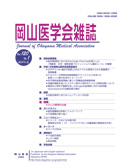

Journal of Okayama Medical Association
Published by Okayama Medical Association<Availability>
Full-text articles are available 3 years after publication.
Permalink : http://escholarship.lib.okayama-u.ac.jp/19221
Studies on the Metabolism of Glucuronic Acid in vivo Part 1 Studies on the determinative methods of glucuronic acid value and the clinical significance
Shokaku, Masatoshi
Published Date
1959-02-28
Abstract
It was well known that glucuronic acid played a important role as a combining antidote in vivo, but few determinative methods of glucuronic acid value are useful for a clinical aplication. Therefore, the determinative methods of glucuronic acid were first investigated and then glucuronic acid value in blood and urine, in health and disease, were observed. And the results were as follows. 1. The Fishman's determinative method of glucuronic acid value was confirmed to be useful for a clinical application, since it was compared with the original method for the determination of glucuronic acid value on the minuteness, singularity and recovered property by the use of naphthoresorcinolcarbon acid barium. 2. The value of glucuronic acid in blood of healthy adults was 7.1 mg/dl in male and 6.8 mg/dl in female, and it's total excretive dosis in urine was 363.7 mg in male ang 327 mg in female. The density of glucuronic acid in blood showed no change for 24 hours, but it's excretion in urine was so high in the morning that the total execretive dosis of glucuronic acid into urine should be measured with 24 hours' urine. 3. As the singularity was not observed on the excretive dosis of glucuronic acid by the intravenous administration of glucose, it was thought that glucose did not directly participate in the combination of glucuronic acid. 4. Glucuronic acid was, in some degrees, accumulated in blood by the administration of glucuronic acid, and it could be partly utilized for the combination. 5. In liver diseases, the total excretive dosis of glucuronic acid into urine showed markedly decreased and the value of glucuronic acid in blood also showed decreased with the degree of liver damage, but at the early stage of acute hepatitis, some cases showed the high value of glucuronic acid in blood, in opposition to the decreasion of it's excretion into urine. 6. In the cases with longstanding fever, like the case of subacute bacterial endocarditis, the excretive increasion of glucuronic acid into urine was observed. 7. In the cases with the administration of PAS, the total excretive dosis of glucuronic acid into urine showed the increasion, and it was thought that PAS was participated in the combination of glucuronic acid. 8. In half of the cases with habitual constipation the excretion of glucuronic acid into urine showed the increasion, but it became showing the normal value on the measurement of glucuronic acid after thebowel movement in those cases showed the high excretion of glucuronic acid into urine. 9. In other diseases, Basedowe disease, sypinal sphilis, thrombocytopenic purpura, stomach ulcer, duodenal ulcer, myelitis and cholecystopathy etc., no significant tendency was observed on the excretion of glucuronic acid.
ISSN
0030-1558
NCID
AN00032489
